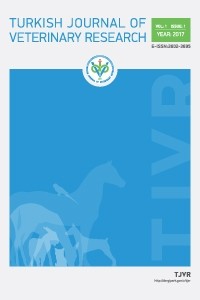
Turkish Journal of Veterinary Research
Yazarlar: Wahidur RAHMAN, Md. HOSSAİN, Md. ALİ, Tania SULTANA, K. M. Mozaffor HOSSAIN
Konular:Veteriner Hekimlik
DOI:10.47748/tjvr.893959
Anahtar Kelimeler:Chickens,E. coli,Prevalence,Antibiotic resistance,ESBL
Özet: Objective: Indiscriminate use of antibiotics in poultry farms increases the chance of antibiotic-resistant and ESBL producing bacteria in Bangladesh. Therefore, the study was undertaken to detect the extended-spectrum β-lactamase (ESBL) producing Escherichia coli (E. coli) in chickens. Materials and methods: A total of 60 cloacal swab samples (20 from commercial layer, 20 from commercial broiler, and 20 from commercial Sonali chickens) were collected from the Rajshahi district of Bangladesh. The E. coli was isolated from these samples and identified based on cultural, staining, and biochemical characteristics. The disk diffusion method was used to assay the antibiotic-resistant/sensitivity patterns of the isolated E. coli. Phenotypic detection of ESBL producing E. coli was also done. Results: The prevalence of E. coli in chickens was 61.67% in the Rajshahi district of Bangladesh, where the prevalence was 60%, 60%, and 65% in a commercial layer, commercial broiler, and commercial Sonali chickens, respectively. The antibiotic sensitivity assay of E. coli isolated from commercial layer chickens showed 100%, 80%, 50%, 40%, and 40% resistant to amoxicillin, tetracycline, cefotaxime, ciprofloxacin, and ceftazidime, respectively. E. coli isolated from commercial broiler chickens showed 100%, 100%, 60%, 50%, and 40% resistant to amoxicillin, tetracycline, cefotaxime, ceftazidime, and ciprofloxacin, respectively. E. coli isolated from commercial Sonali chickens showed 90%, 70%, 50%, 50%, and 40% resistant to amoxicillin, tetracycline, cefotaxime, ciprofloxacin, and ceftazidime, respectively. In phenotypic detection, the overall prevalence of ESBL producing E. coli was 43.33%, where 40%, 50%, and 40% in the commercial layer, commercial broiler, and commercial Sonali chickens, respectively in the Rajshahi district of Bangladesh. Conclusion: These results indicated that chickens are a potential reservoir for ESBL producing E. coli and their antibiotic resistances are obviously significant. These findings will help us to make a proper guideline for the treatment, prevention, and control of E. coli prevalent in chickens in Bangladesh